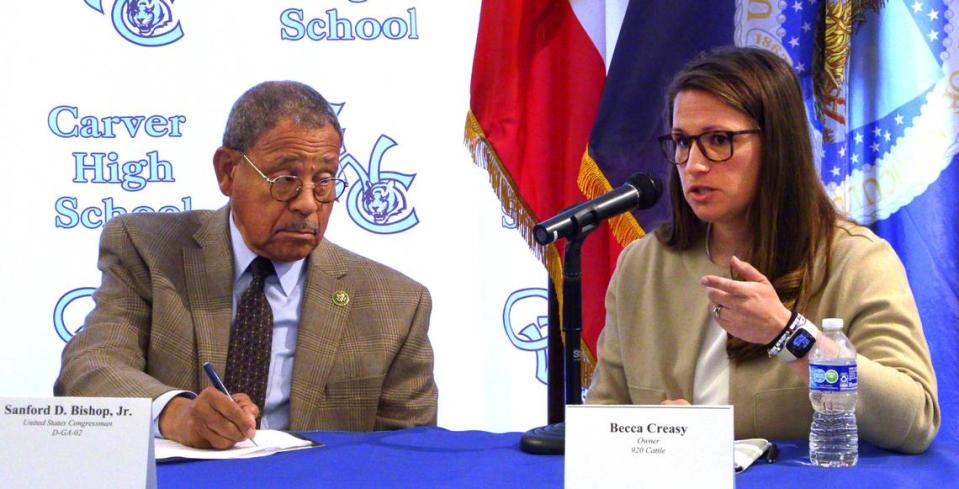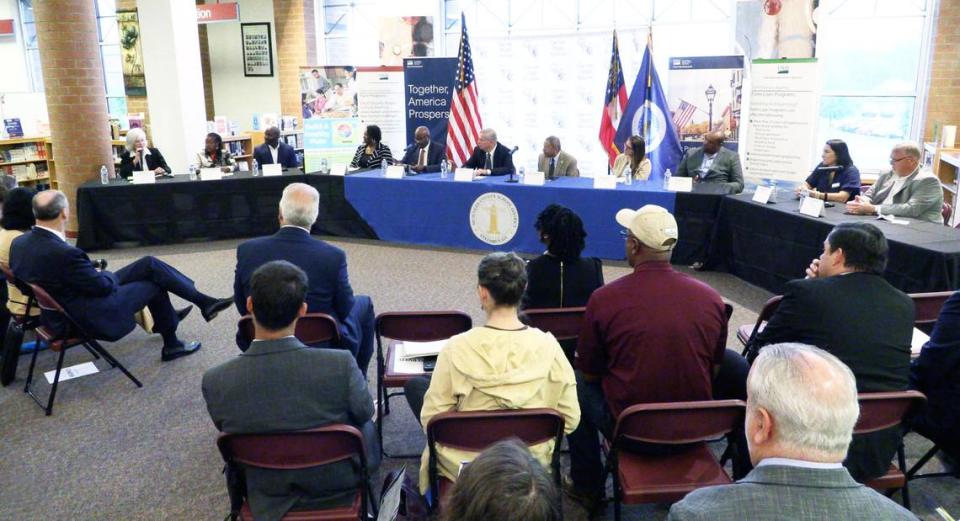U.S. Secretary of Ag highlights progress and threats to farming during Columbus trip
The farming population is shrinking in the U.S. from compounding forces like extreme weather events that hinder growing conditions and financial hardship to sustain farming income.
There were fewer farmers in 2022 than in 2017, and in those five years, Georgia lost 3,175 of them, the majority under 50 acres, according to the Department of Agriculture’s 2022 Census.
With those sobering statistics, the head of the nation’s agriculture department and a Georgia congressman were in Columbus to address those trends at an Investing in America round table discussion at Carver High School.
U.S. Secretary of Agriculture Tom Vilsack, who was the former governor of Iowa, and Georgia Rep. Sanford D. Bishop (D-District 2) touted the progress of the American Rescue Plan.
They announced funding for local farmers and discussed some of the pressures from the latest proposals of the Farm Bill.

The Farm Bill, which is updated every five years, was extended from its update in September 2023 to 2024, because Congress couldn’t reach an agreement on allocating funding.
Vilsack and Bishop are hopeful the climate guardrails will be kept in place and funding will be allocated to protect all of the farmers, not just some. Vilsack has made climate change and sustainable farming practices one of his key initiatives serving under President Joe Biden.
The latest draft, released last week, will be presented by Glenn “GT” Thompson (R-PA), the House Committee on Agriculture chairman, and will be reviewed and marked up by the Committee next week.
“We hope that we will have a product that will manage the risk and provide a safety net for our producers,” Bishop said.
The current proposal shows a 10-20% subsidy for “price reference crops,“ (think the major crops like corn, rice, wheat, soy) to help with inflation. But critics say that subsidizing price reference crops only helps the bigger producers, not all farmers.
“Inflation doesn’t just affect cotton, rice, and peanut farmers, it affects all farmers,” said Scott Faber, senior vice president of Governmental Affairs at Environmental Working Group. “This proposal to increase price references will overwhelmingly benefit the largest white producers of those three crops.”
Vilsack asked the crowd a question that addressed Faber’s point.
“Are we okay with a system that accelerates the loss of farm and farmer?” Vilsack said. “The last three years of farm income were the best three years of farm years in the last 50 years. But only 7% of farms received 85% of the funding.”

The climate realities
Though Georgia is verdant, it is currently categorized as the fourth-most vulnerable state to drought, according to the most recent report by the climate vulnerability tool developed by the Environmental Defense Fund and Texas A&M.
Muscogee County and other Southwest communities are in the 90th percentile for vulnerability. Additionally, the annual loss of farmland from climate change and projected changes in crop yields in Georgia is in the top 50%.
“All agricultural production is threatened by climate change,” said Andrew Lentz, Environment Defense Fund director of federal affairs for agriculture policy. “Agriculture is unique in that it continues to (be hit by) climate change and it is part of the solution. These farmers can adopt various conservation and land stewardship practices and build resilience to the worse effects of climate change such as soil erosion and drought.”
Part of the 2022 Inflation Reduction Act’s legislation was allocating $20 billion dollars to conservation programs within the USDA to support “climate-smart” and local agriculture.
The USDA announced $3.1 billion for the climate-smart effort, including $892.6 million for 28 projects in Georgia.
One of the projects has about 10 farmers planting chestnut trees in Georgia.
“We’re supplying farmers with chestnut trees because they can sequester more carbon than any other nut tree,” said Hal Robinson, legal affairs director of Georgia Land Trust. “They take five to seven years to grow and create revenue so we’re funding tens of thousands of dollars for the first year to get started and set up. We’re directly funded by the climate-smart program.”
Another climate-smart project is Kristie Wendelberger’s test of how to terminate specialty crops. Her team, Southern Piedmont, has 30 different farms in the southern region willing to see how to terminate specialty crops like tomatoes, winter squash, leeks, and cabbage in a way that is more sustainable.
“We’re paying for the entire set up and seeing if the thick layer of dead plant that has been ‘roll crimped’ (like steam rolled over) will protect the plants from weed control, add nutrients, and add moisture more than using a black plastic mulch,” Wendelberger said.

Emmanuel Bankston works for ADM, a massive seed company that purchases and transports crops, in Headland, Alabama.
“Before the IRA I was in a different position and they created my position just to do climate smart agriculture,” he said. Bankston, now the climate-smart procurement manager of the Southeast Region at ADM said farmers are enjoying incentives. “We’re paying attention soil health and adding cover crops to create more organic material and harness soil moisture.”
Climate-smart practices under threat?
The work of the climate-smart practices and the conservation resources are potential under threat by the latest proposed farm bill by the House.
Next week is just the first step of the Farm Bill’s evolution. If it passes, it then goes to the Senate where Senate Agriculture Committee Chairwoman Debbie Stabenow (D-MI) has a proposal that will protect climate guardrails and the Inflation Reduction Act funding.
Bishop is one of the committee members. Bishop said voters should contact their representative in Congress to let them know their feelings and why it’s important to keep certain policies in the bill.
“If enough people express themselves, hopefully people who are drafting the bill will consider these policies,” Bishop said.
An urban garden gets a nod
Before Bishop and Vilsack’s round table discussion at Carver High School, they stopped by Turn Around Columbus to look at the latest efforts of the victory garden, one of the few urban gardens in Columbus.
The farm touched Bishop.
“It is an incredible urban farm,” he said. “It was inspiring to me to listen and hear the impact it’s having on young people. It almost brought me to tears.”
Vilsack announced a $145,000 grant Turn Around Columbus will receive from the USDA farm service agency.
“That is a big deal,” Bishop said. “It will fund a tractor, a mobile outdoor classroom, transportation for outdoor training, as well as farming supplies. The funds were made possible by the American Rescue Plan.

